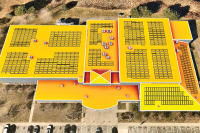Living off the grid for 40 years
In a book written in a first-person, vulnerable and intimately entertaining narrative oral storytelling voice, Ken Smith takes us through his entire life — of youthful globe-trotting adventure and hardship, to an eventual life of self-sufficiency and spiritual awareness in Scotland.
Sun power supplies a path to simplicity
Lydia Aydlett first moved to the mountains of Western North Carolina during the height of the back-to-the-land movement, and it’s taken her all the time since to understand why living a sustainable life is so important to her.
Aydlett grew up in the eastern part of the state, near Elizabeth City, during the 1950s and ‘60s. She moved to the Piedmont region with her husband, a banker, and when the marriage failed, she decided to make a change.
“I was really interested, even then, in finding alternatives to the intense consumption that had been taking place all around me,” said Aydlett.
Aydlett bought a white farmhouse and 25 acres and moved her two young children to the area between Sylva and Cullowhee in 1978.
“We’d been through the ‘60s so there was a lot of ‘f—- the establishment.’ Feminism was a part of that for me and of moving myself to the mountains by myself with my kids,” Aydlett said.
What Aydlett found in the mountains of Western North Carolina was a sense of community.
“This was the back to the land time. Lots of returning Vietnam vets. There were people from around the country who had come to this area to live the homestead life,” Aydlett said.
Aydlett had friends who lived in teepees and broken down barns and there was still music in the air. She remembers chanting and spinning at Sufi dances held at Caney Fork Community Center, where the good ole boys would come to watch them and drink beer.
“It was a bunch of hippies who were thoughtful people and were trying to sort things out,” Aydlett said. “Some of them are still around.”
But while her experience in the early ‘70s gave Aydlett a taste for rural living, she didn’t necessarily get close to the environmental principles she espouses today. For instance, at that time, the thought of killing a chicken for food disgusted her.
“I was working full-time and raising kids and just kind of scrambling to keep life together,” Aydlett said.
Having gotten a master’s degree at Western Carolina University, Aydlett worked with young children with developmental disabilities and raised her family.
It was when she went back to school again at University of North Carolina-Chapel Hill to pursue a doctoral degree in 1984 that Aydlett rediscovered her fervor to live life differently.
She spent her time in Chapel Hill in a co-housing community that espoused sustainable living in close quarters.
“That community boosted my consciousness and let me know that this could be done,” Aydlett said. “And when I say ‘this’ I mean living a sustainable lifestyle. One that’s more self-contained and has a shorter feedback loop.”
When Aydlett came back to teach at Western Carolina, she sold three acres and the white farmhouse and began work on building a sustainable homestead high on the ridge on Robertson Mountain.
Friends of hers from Chapel Hill helped her build a 16-by-16-foot cabin that ran off of solar power, had a composting toilet, and well-water driven by gravity.
Living in the cabin was an intermediate step, and it taught Aydlett a lesson about what she wanted. She didn’t want to live THAT simply.
Now her house runs off solar electricity and has a solar water heater which Aydlett augments with a propane generator and a propane stove. She has a dishwasher, a television, and a pro-audio system.
It’s not about living an austere life, Aydlett said, but about being connected to what you use.
“If I use too much electricity I know it. If a person in a conventional house does, they just have to pay a little bit bigger bill,” Aydlett said.
Aydlett has begun growing her own vegetables in a large terraced garden above her house, which she feeds with rainwater. After collecting water in rain barrels under her downspouts, she pumps it uphill to a holding tank so she can use gravity to water her beds.
Aydlett also maintains a small goat herd, 20 chickens, and one large Great Pyrenees to keep them safe from coyotes and wandering pit bulls.
Last week she killed a rooster for the first time with help from friends, and she’s getting used to the idea of doing it again. As Aydlett has matured, so has the environmental movement. She marvels at the political infrastructure in place now to advocate for sustainable living.
But she has come to believe that it’s the practical day-to-day connections to the earth that are most valuable to her.
“I’m really glad [the movement] is out there, but it’s not the same as being aware that because we’ve had three cloudy days the battery bank has gotten low,” Aydlett said.
Aydlett still works part-time as a counselor of children. She is by no means a hermit on her mountaintop. Her life has taken her on a journey, and now the ideologies that drove her decisions in her youth are taking root in new ways.
“I don’t hold to the ideologies with the same fervor as I did then but they certainly have fed my growth and helped create my path,” said Aydlett. “It’s more of a feeling thing than a thinking thing now.”
Back to the old homestead
Sometimes you have to go away to come home again.
Way up Coweeta Gap in south Macon County is a place at the end of Shope Road called Sanders Knob. Paul and Lara Chew live there in a cabin that was built around 1850, and for Lara, the homestead represents an ironic intersection of her ancestral roots and her living present.
“I grew up hearing all the stories she told and I wanted to come back and see the place,” Lara said. “Once I saw it, I wanted to be here.”
Lara’s grandmother was a Jones from Jones Creek who married Monroe Sanders and moved to the gap. Monroe Sanders died, alongside Cicero Shope, after the two men quarreled over a hog around the time the fence laws changed. The old cabin that Paul and Lara live in now was Cicero Shope’s home.
After the killings, Lara’s grandmother moved the family to north Georgia to work in the mills there. They lived the simple life, raising hogs and chickens, tending gardens, and foraging for wild edibles to augment what they brought back in pay.
When Lara was growing up in Georgia, she learned how to live in the country, but like other young people her age, it wasn’t what she wanted for herself. She wanted modern things, a larger world. At least for a while.
After a career as a schoolteacher and raising children, Lara began to yearn for the old home place she had heard about throughout her life. Lara and her late husband, Jesse Jackson, moved to the Shope cabin in 1989 from Gainevsille, Ga.
The cabin was uninhabited, covered in honeysuckle, its windows blown out and the hearth turned into a copperhead den. Jesse and Lara bought the place and 50 surrounding acres. To stake their claim, they had to kill seven copperheads the first weekend.
“We just sort of camped out here until we could really live in it,” Lara said.
Back then, the cabin was off the grid in the old sense. Lara and Jesse lived there for 12 years without electricity. Lara worked in the Macon County school system and Jesse worked for a long time as a groundskeeper in Highlands. There were nights when the snow would filter though the walls and cover the bedspread.
When the couple was home, they took care of their goats and chickens and Lara taught herself to forage for wild edible and medicinal plants.
Jesse died and Lara stayed on the place, committed to the ground her ancestors had cultivated.
Inspired by Evell Gibbons’ book Stalking the Wild Asparagus Lara found ways to make use of the things that grew on her land.
“I realized there were so many things to eat that no one used anymore,” Lara said.
This year the Chews made a batch of pokahickory from 200 pounds of hickory nuts foraged on their land. After a crushing, a soaking, and a boiling, the nuts produce a rich drink that tastes a bit like hot chocolate.
Lara has also taught herself to make baskets from pine needles and sundry other skills. Using the land is important to the Chews.
They have raised hogs, chickens and goats, made their own butter, cheese and head cheese. They grow their own corn and grind it for meal. They operate their own sawmill for lumber. They bake their own bread in a clay oven they made out of the mud from their creek. They use a composting toilet.
Lara doesn’t like to waste anything, not even chicken feathers, so she’s learned how to tan chicken skins and turn them into hats.
“We’re not isolationists,” Lara said. “I think one of the things I like about the way we live is I can have my cake and eat it too. I can have the adventure my grandparents had, but I can also get in the car and go to town.”
Paul Chew’s path to the Shope’s cabin was also a windy one. Having grown up in Los Angeles in the ‘60s the child of an ecologist and a botanist, Paul moved to Athens, Ga., for high school. He was a hippie and had a yearning to connect to the land. But he eventually got a degree in metal work and settled into a life teaching high school metal shop in Oglethorpe County.
Still interested in the agrarian lifestyle, Chew started an organic farm. He threw himself into the lifestyle, but found he didn’t have time to enjoy what he was doing.
“It was very demanding. I was busy all the time,” Chew said. “I guess Lara kind of rescued me.”
Paul and Lara met at the John C. Campbell Folk School and he later followed her back to the homestead.
“It was pretty amazing,” Paul said. “The cabin and the solitude here.”
Lara and Paul’s careers as teachers haven’t stopped. They now welcome young people affiliated with the World Organization of Organic Farmers to their home throughout the year –– they had nearly 30 WOOFers last year –– to learn how to live with the land.
For Lara, teaching young people how to live off the land is about preserving knowledge.
“To me it’s ‘Don’t let the information die’,” Lara said. “I know there are books out there, but it’s not the same as learning the way it is.”
But Paul, who remembers a formative trip to the Chiricahua Mountains of Arizona as a child, believes living off the land is also about finding internal confidence.
“The motivation for this kind of life is doing what you have to do to survive,” Paul said. “It’s really about the confidence that you’re not just depending on other people around you.”
Having grown up with professors, Paul says his own mission is intimately linked to the environmental movement.
“What we’re about here in part is learning how to live more lightly on the earth. We’re trying to evaluate what our impacts are on the land,” said Paul.
The energy behind the Chews homestead now comes from a sophisticated water-powered turbine system that produces 1,200 kilowatts per hour. Paul has worked alongside the Chews’ neighbor to divert a mountain stream through a filter into an 800-foot pipe that feeds the twin turbines.
The electricity is stored in a battery bank that connects to the hot-water heaters in the two cabins on the property and powers the lights and laptops.
The Chews also drive a converted electric car that boasts a pop-up solar panel on its roof for summer driving. Paul is constantly tinkering to gain a mechanical advantage on nature.
Meanwhile, Lara Chew has authored three children’s books, much of the material based on stories she heard from her grandmother. There is nothing simple about the Chews except the rules they live by.
“Whatever comes out of the land, we try to put back in,” Lara said. “Nothing is wasted.”
Where ideology meets environmental reality
The term “off-the-grid” means living in a self-sufficient manner without the services of a public utility. Wikipedia estimates that in 2007 there were around 250,000 off-the-grid households in the U.S. that supplied their own water, electrical and sewer systems.
Living off-the-grid has been characterized by the sustainable living movement as the ultimate step towards reducing energy consumption. It’s more affordable these days than in the past, because of dramatic improvements in wind, water, and solar power mechanics.
In the U.S. “going green” has become increasingly scientific and less and less ideological, but the roots of the environmental movement can be found in the back-to-the-land movement that ran through the late 1960s and early 1970s.
The American back-to-the-land movement was a migration from urban to rural environments that created a blip on the country’s demographic trends in the latter half of the 1960s and the early part of the 1970s. The values of the movement are exemplified in Helen and Scott Nearing’s book Living the Good Life, which chronicles the couple’s self-sufficient lifestyle in a Vermont farmhouse. Published in 1954, the book cites the economic pressures of the Great Depression and the influence of the writings of Henry David Thoreau as driving inspirations.
The back-to-the-land movement drew on both the pragmatic self-sufficiencies celebrated in rural America during the Depression and on the literary and philosophical celebration of the American continent. Also, a growing discontent with government policies and rampant consumerism drove members of the counter culture to search for a divergent set of values, which they found in rural communities that had been resistant to change and maintained closer contact with nature.





